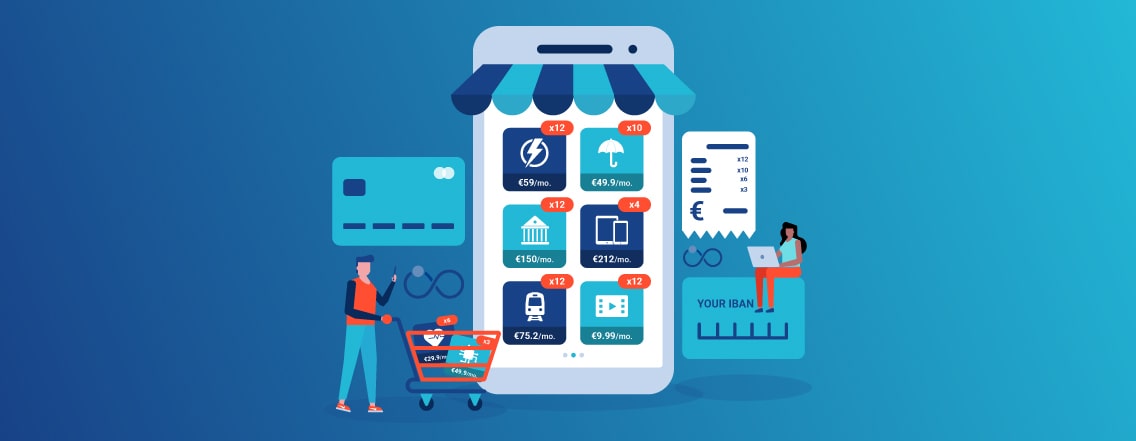Consumers want to buy on their own terms, in a flexible and frictionless manner. Not all consumers are the same, and they don’t all fall in the neat subscription category. We are in a new era of buying behaviors, creating the need for a new, user-centric economic model.
In the Repeat Economy, there is no limit on quantity, volume of purchases or seasonality. Consumer habits are constantly evolving. Encouraged by the crisis or natural technophiles, more and more people are using the Internet to contract services and make purchases.
Digital payments keep the world moving. Every year, millions of customers make billions of transactions across different devices, with multiple payment methods. Moreover, today, companies are able to offer scalable services, thanks to technology and data.
Today’s digital ecosystem requires economic players to be aware of user interests and to adapt not only their range of products and services – online and offline – but also payment methods and data protection.
Consumers are informed, responsible and committed buyers, mainly looking for a usage that fits their specific needs, rather than owning actual products. Gone are the days where the relationship with a company is a simple one-off transaction. The new, prevailing mindset is: “why own something when I can subscribe to it?”.
This is where the notion of subscription appears, widely favored by well-known players like Deezer, Netflix, Spotify and others. Having the freedom to use the service anywhere, anytime, is what best defines the “Subscription Economy”.
Subscription models are one of the fastest-growing business models in recent years. However, it doesn’t work for everyone, and not all companies are ready to change their business model.
Consumers want to buy on their own terms, in a flexible and frictionless manner. Not all consumers are the same, and they don’t all fall in the neat subscription category. We are in a new era of buying behaviors, creating the need for a new, user-centric economic model.
Netflix-like subscriptions: is the actual subscription business model convenient to all?
With a subscription system, the model itself is designed to provide consumers with a lasting customer experience, offering advantages for both consumers and merchants. Consumers benefit from exclusive access and immediate availability of the product or service. Merchants, in turn, have a steady flow of revenue and can better forecast their profits for the year.
As a business model, online subscriptions are quite solid. In France alone, the marketplace had nearly 50 million active subscriptions in 2021, or nearly 9% of the European market. The French market value already exceeds €5 billion, and is expected to double by 2025.
Online subscriptions attempt to penetrate every sector. Industries that were previously far from the subscription business model are now converting to it, one by one. Examples include the UK-based Pret A Manger restaurant chain, with a beverage subscription, and the French-based Maison de la Literie, with its bed and mattress subscriptions.
Subscription-based payments offer the possibility of “order once, use many times.” The biggest problem with this model is that it is just as easy to subscribe to a service as it is to unsubscribe, which results in losing customers. In addition, the subscription model pigeonholes all customers, attributing the same needs, habits and behaviors to them. However, nothing could be further from the truth. Many customers are not easily labeled (they consume at different frequencies, in different quantities, in different ways).
Buy what you want, when you want it – the Repeat Economy. A solution for the new digital consumers?
Subscription and repeat purchases help build customer loyalty. Customer acquisition has become increasingly expensive in recent years and is no longer sufficient for growth alone. In the last six years, the cost of acquiring new customers has increased by 60%. Marketing has grown much more expensive, and customers are much less loyal to brands than before.
As services become increasingly personalized and customizable, the subscription model has shown its limits.
Many services or products are still not available by subscription. Consumers must make an additional effort to get these services or products. Not to mention those that are available, but that are not suited to their needs. Consumers are more demanding than ever. They want to be able to use the service whenever they want, no more, no less.
Repeatedly, but not contractually, consumers expect merchants to provide them with services and products that maximize their satisfaction on a number of fronts, including sustainability. For these types of scenarios, the notion of subscription is not appropriate. This is where the concept of Repeat Economy or recurring purchase comes into play. This strategy allows merchants to focus their costs and efforts on the customer experience. The Repeat Economy is a way to maintain the relationship between consumers and merchants, whether they order once or many times. In the Repeat Economy, there is no limit on quantity, volume of purchases or seasonality.
Among the first to introduce this notion were Uber and Amazon. There is no need to subscribe to occasionally take an Uber or to make repeat purchases on Amazon. Above all, the most important thing for the consumer is to be able to order an Uber with a single click without having to re-enter personal or payment information – a truly frictionless payment process.
To facilitate repeat purchases, the customer journey needs to be multi-device, multi-channel, secure and frictionless. The payment process must be made as easy as possible, offering the desired product exactly when they need it. It is best to take consumers directly to their shopping cart that is already filled with the product or solution they are interested in, and guide them through the payment process in a few clicks.
Payments are a vital part of the entire shopping experience. Without a seamless checkout experience, customers are more likely to abandon their shopping carts. In 2020 alone, failed payments cost the global economy $118 billion.
Merchants need a secure, stable and scalable payment platform to reduce failed transactions and retain customers. SlimPay uses innovative payment methods that can be combined according to the customer’s economic model, increasing retention and providing a secure and frictionless payment experience. SlimPay accelerates digital transformation and contributes to business growth within the Repeat Economy by adapting to one-off and repeat buying behaviors.




